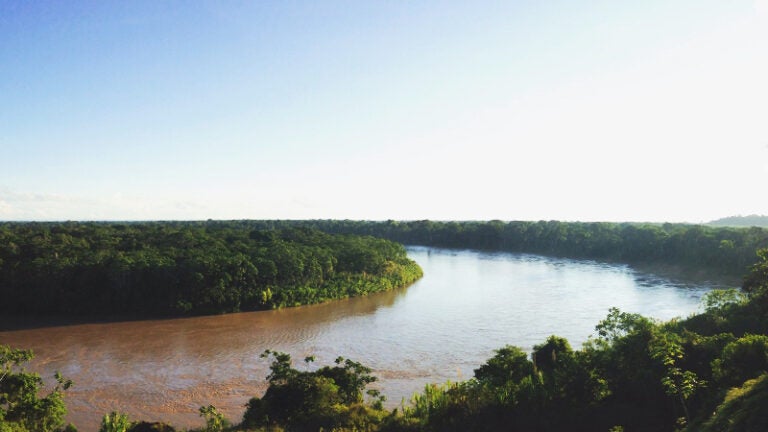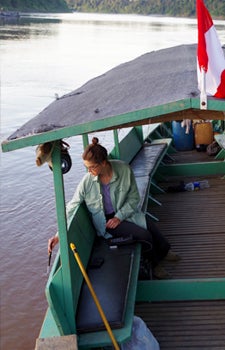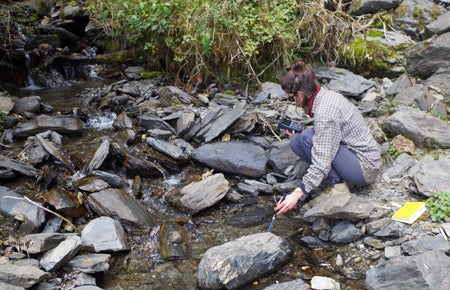
To understand watersheds, the Amazon flood plain is her laboratory
The Amazon River is the world’s largest river, flowing from headwaters in the Peruvian Andes thousands of miles east across Brazil through mountains, forests and plains, finally spilling into the Atlantic Ocean. Emily Burt, a Ph.D. student in the USC Dornsife Earth Sciences Department, studies this land and water system, known as the Amazon River watershed.
Her research seeks to understand how water moves through a watershed — a land area that channels rainfall and snowmelt to creeks, streams and rivers, and eventually to outflow points such as lakes, bays and the ocean. Conducting her research mainly in Peru, she uses the Amazon flood plain as a natural lab to investigate how dramatic environmental gradients like large changes in elevation, topography, temperature and forest type can affect the way that watersheds work.
“I’m really interested in the processes that happen as rain falls on a watershed, moves through the ground and becomes water that you see in a river,” she said. By learning how such a dramatic environment functions, her work can help scientists understand how more basic land features, such as elevation or topography, can influence other environments.
A dive into sulfur
Geology piqued Burt’s interest during her sophomore year of college at the University of Pittsburgh. After taking an Earth sciences class, she started working in her professor’s geochemistry lab.

Using a pH meter, Burt tests the pH levels of the water to understand how much pyrite and sulfuric acid are present in different streams.
Burt found geochemistry — the study of the chemical composition of the Earth — to be incredibly useful. “You can learn about so many key environmental processes from basic science to human impacts on the environment,” she said.
Now a fourth year Ph.D. student in Joshua West’s laboratory at USC Dornsife, Burt will use the 2019 Spring semester to advance her doctoral research on watersheds. She was recently awarded a grant from the U.S. Department of Energy (DOE) Office of Science Graduate Student Research (SCGSR) program to support her studies at the Lawrence Berkeley National Laboratory, a DOE national lab at the University of California, Berkeley. The SCGSR program provides outstanding graduate students the opportunity work with experts and make use of the resources at DOE facilities for their dissertation.
Burt will be working with Berkeley lab researcher John Christensen, who specializes in isotopic geochemistry, a subset of geology dedicated to understanding the various chemical elements of rocks, air or bodies of water. Alongside Christensen, Burt will investigate how sulfur sources cycle across the Andes and the Amazon.
Pyrite — sometimes called “fool’s gold” — found in the Andes reacts with water and oxygen to produce a lot of sulfate and a lot of acid. The acid breaks down rocks and delivers a great deal of sulfate into the river system.
“I’ll be using geochemical tools to understand where sulfur is coming from and how much of it microbes are using,” Burt explained. “Since sulfur is such a key biogeochemical element, we want to be able to understand how it’s working in this major water system.”
Mentors make the difference
Burt looks forward to learning from Christensen’s expertise. As a graduate student, she sees the benefits of mentorship. She herself has been a mentor in the USC Young Researchers Program, which pairs local high-school students with doctoral students and faculty at USC.

Testing pH in the water.
For six weeks during the summer, high schoolers conduct research, attend weekly STEM workshops and learn about pursuing careers in the sciences. They present the findings of their research at a poster symposium at the close of the program.
Burt began as a mentor and now coordinates the USC Young Researchers Program. She said there’s something to be gained through mentorship for both the mentor and the mentee.
“Grad students learn how to guide someone through a project and make sure they’re seeing something through from start to finish. They also have to learn how to make information accessible to high school students,” she said.
The mentees learn that they are capable of taking on a big research project, which builds their confidence, she said.
“At the end, they have something tangible. They can say this is the question I set out to answer, these were my results and this is what I learned along the way.”